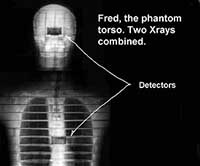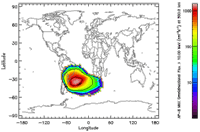The South Atlantic Anomaly
The Vile Vortices are areas of the Earth where unearthly occurrences are frequent. The South Atlantic Anomaly (SAA) is one of the Vile Vortices. However, unlike the instrument malfunctions and disappearances of aircraft and sea craft reported in the Bermuda Triangle and the Devil's Sea, the South Atlantic Anomaly is famous for the malfunctions generated in spacecraft and the mysterious physical phenomena reported by astronauts.
Encircling the Earth like a large lifesaver, the Van Allen belt is a two-banded radiation field that forms the Earth's magnetic field. The Van Allen belt traps radioactive particles that originate from solar flares and shields the Earth from the strong solar winds that emanate from our sun. The band closest to Earth traps protons and the band furthest from the Earth traps electrons. The proton belt is 1200-1300 kilometers (750 to 800 miles) high except for one spot; over the South Atlantic Anomaly, off the lower coast of Brazil, it dips as close as 200 kilometers (about 124 miles) from the Earth's surface1. The figure above shows the radiation density of the Van Allen belt over the SAA, red being the most intense.
Our space craft generally fly below the proton belt, but over the SAA, the proximity to Earth puts our satellites, the ISS (International Space Station) and even the Space Shuttles in the path of the intense radiation generated by the trapped protons of the inner Van Allen Belt. As spacecraft pass over the South Atlantic Anomaly, instruments often malfunction or lock up entirely.
- ROSAT was an x-ray observatory that flew during the 1990s. Its position sensitive proportional counters had to be turned off as it passed through the SAA to prevent severe damage.
- In 1999, NASA launched the Terra Earth Observing System (TEOS) to study global climate change. As the system passed over the South Atlantic Anomaly, just one day after launch, an anomalously high current passed through its motor drive assembly, sending its antenna into "safe mode" and preventing it from communicating data to tracking and data relay system satellites.
- In 2001, NASA's MODIS satellite was rendered inoperative as it passed through the SAA. It took over two weeks to get the satellite back on line.
- The Hubble Space Telescope experiences gyroscope failures and errors in communications as it passes through the SAA1, 3.
- The SAA causes random upsets in the altimeter of the Topex satellite as it flies at an altitude of 1000 kilometers.
- Space Shuttle observations are interrupted by instrument disruptions when the Columbia passes through the SAA2.
- Astronauts report seeing random flashes of light—with their eyes closed. These flashes are believed to be caused by particles striking sensitive areas of the retina1.

As well as disrupting electronics, high-energy particles that pass through the human body can disrupt cell function. Although no astronauts have experienced space radiation sickness, concern over how flying through the SAA might affect the health of astronauts led NASA to create Fred. Fred, "The Phantom Torso" was developed to measure the amount of radiation to which astronauts are exposed4.
Phantom Fred had no arms or legs, but he did have a heart, brain, thyroid, colon and other organs made from a special made plastic that closely matched human tissue. After constructing Fred, NASA sliced him into 35 horizontal sections and installed dosimeters (radiation detectors) in each section. Then Fred was deployed to serve a 4-month mission on the International Space Station.
A total of 416 lithium-based dosimeters recorded the total radiation dose received during Fred's mission. Five active silicon diode detectors, placed in the Phantom's vital organs, tracked the times that the radiation exposures took place. Fred's mission was successful and gave NASA the information it needed to conclude that space travel is safe... even flying through the South Atlantic Anomaly.
2. Takafumi Hamaoka. “Environmental Health in Space.” Environmental Health Perspectives 1 Jul 2001. 19 Sep 2008 <http://www.highbeam.com/doc/1G1-78963511.html>.
3. Ron Cowan. “Gyroscope flaws: Hubble spins its wheels. (electrical glitches plague the Hubble Space Telescope).” Science News 10 Aug 1991. 19 Sep 2008 <http://www.highbeam.com/doc/1G1-11202268.html>.
4. The Phantom Torso.” NASA 4 May 2001. 21 Sep 2008 <http://science.nasa.gov/headlines/y2001/ast04may_1.htm>

